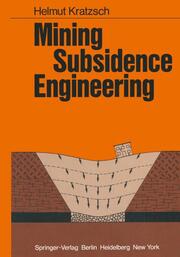Detailansicht
Mining Subsidence Engineering
ISBN/EAN: 9783642819254
Umbreit-Nr.: 4151678
Sprache:
Englisch
Umfang: xii, 546 S.
Format in cm:
Einband:
kartoniertes Buch
Erschienen am 08.12.2011
Auflage: 1/1983
- Zusatztext
- This book originally appeared in German in 1974, under the title "Bergschadenkunde" (mining subsidence engineering), and then in Russian in 1978, published by Nedra of Moscow. When the German edition was almost out of print, Springer-Verlag decided to bring out a new edition, this time in English. For this English version the text has been thoroughly revised, enlarged, and sup plemented by over 100 new figures. The book deals with the current state of international knowl edge on strata and ground movement over mine workings, with its damaging effects on mine shafts and the land surface, and with measures for regulating mining damage in law and reducing it in practice. Discussion begins with the mine excavation underground - the cause - and ends with the damage to surface structure- the effect. Methods of roof control, including the subject of rock bursts, are not discussed, since that is a field concerned more with the safety of underground workings than with minimizing damage at the surface. Of the 500 literature references in the German edi tion, only the more important for an international readership have been retained, but no value judgement on the many pUblica tions not mentioned should be read into this. The book is principally intended as a working aid for the mine surveyor, the mining engineer, the architect, and the civil engineer. For the student and the post-graduate researcher, it of fers a summary and guide to this whole field of knowledge.
- Autorenportrait
- InhaltsangabeI Strata Movement.- 1. Strata Movement at the Mining Horizon.- 1.1 Mining Methods, from the Standpoint of Subsidence.- 1.2 Convergence in the Workings.- 1.2.1 Mining Without Permanent Pillars (Total Extraction).- 1.2.2 Mining with Permanent Pillars (Partial Extraction).- 1.3 Factors Influencing Convergence in the Workings.- 1.4 Horizontal Movement in the Roof Stratum.- 2. Deformation of the Rock Mass.- 2.1 Zones of Movement in the Overlying Beds.- 2.2 Vertical Movement and Deformation.- 2.3 Horizontal Movement and Deformation.- 2.4 Rock Kinematics in Steep-lying Measures.- 2.5 Surface Fracture over Shallow Workings.- 2.6 Chronological Stages in Strata Movement.- 3. The Calculation of Strata Movement.- 3.1 General Assumptions in Calculation Procedures.- 3.2 Calculating Convergence in the Workings.- 3.2.1 The Roof as an Overlying Beam.- 3.2.2 A Roof of Loose Rock.- 3.2.3 The Roof as a Kelvin Body.- 3.2.4 Empirical Formulae for Convergence in the Workings.- 3.3 The Pre-Calculation of Strata Movement.- 3.3.1 The Integration-grid, or Influence-Function, Method.- 3.3.2 The Rock Mass as an Elastic Material.- 3.3.3 The Rock Mass as an Inelastic Material.- 3.3.4 The Rock Mass as a Stochastic Medium.- 3.3.5 The Rock Mass as Finite Elements.- 4. Strata Movement at the Shaft.- 4.1 Subsidence Damage to the Shaft Lining.- 4.2 Bases of the Calculation Procedure.- 4.3 Calculation of Shaft Stress.- 4.4 Superposed Mining Influences; and Tilt.- 4.5 Extent of Vertical Expansion and Contraction in Strata.- 5. Systematic Mining of the Shaft Safety-pillar.- 5.1 Measures to Protect the Shaft.- 5.2 The Mining Plan for the Shaft Safety Zone.- 5.3 Protecting the Shaft Lining Against Mining Damage.- 6. The Influence of Previous Workings and Mining Practice on Strata Movement.- 6.1 The Reciprocal Influence of Workings.- 6.2 The Border Effects of Neighbouring Workings.- 6.3 Changes in Convergence with Multilevel Workings.- 6.4 Coal-pillar Pressure in a Panel.- 6.5 The Influence of Mining Procedures on the Break-up of the Rock Fabric.- 6.6 The Swelling of Clay-bearing Beds.- II The Study of Ground Movement.- 7. The Components of Ground Movement.- 7.1 Historical Development.- 7.2 Ground Movement with Flat-lying Measures.- 7.2.1 Shape of the Trough.- 7.2.2 Calculation of Trough Components.- 7.3 Anomalies in the Trough Outline.- 7.4 Ground Movement in Steep-lying Measures.- 8. The Pre-calculation of Ground Subsidence.- 8.1 Varieties of Calculation Procedure.- 8.2 Empirical Methods.- 8.2.1 The Angle-of-Intersection Method.- 8.2.2 The British Profile-curve Method.- 8.2.3 The Russian Profile-curve Method.- 8.2.4 The Polish Profile-curve Method.- 8.2.5 The Hungarian Profile-curve Method.- 8.2.6 The Programmed Profile-curve Method.- 8.2.7 The Empirical Integration-grid Method.- 8.3 Methods Employing Influence Functions.- 8.3.1 The Theoretical Basis.- 8.3.2 The Graphical Method in Flat-lying Measures.- 8.3.3 Methods for Adapting to Distorted Superposition.- 8.3.4 Integration Grids in Steep-lying Measures.- 8.3.5 Semi-graphical Methods, and Methods Employing Analogues.- 8.3.6 Programmed Calculation of the Influence Factor.- 8.4 Methods Employing Theoretical Models.- 8.4.1 The Stochastic Model.- 8.4.2 The Elastic Model.- 8.4.3 The Plastic Model.- 8.4.4 The Finite-Elements Model.- 9. Pre-calculation of Ground Displacement.- 9.1 Special Features of Displacement Calculation.- 9.2 The Focal-Point Method.- 9.3 The Method with Influence Functions.- 9.3.1 Deriving the Grid from the Focal-point Formula.- 9.3.2 Deriving Displacement from Curvature.- 9.3.3 Displacement by the Statistical Theory.- 9.3.4 Displacement Grids for Inclined Measures.- 9.4 Calculating Displacement from Tilt.- 9.5 Methods Employing Theoretical Models.- 9.5.1 The Stochastic Model.- 9.5.2 The Elastic Model.- 9.5.3 The Plastic Model.- 9.6 Displacement as Observed on Strata Models.- 9.7 The Graphical Method of the U.K. National Coal Board.- 10. The Time Factor.- 10.1 Significance of the Time Factor.- 10.2 A
